HSBC Group: Corporate Governance Board Appraisal Report
VerifiedAdded on 2023/06/08
|8
|2330
|64
Report
AI Summary
This report provides a comprehensive analysis of HSBC Group's corporate governance practices, board structure, and diversity. It begins by discussing the application of agency theory within HSBC and outlines the governance legislation, principles, and guidelines the organization adheres to. The report then compares the board structure and committees of HSBC with those of National Australia Bank (NAB), a competitor, examining their functions, membership, and responsibilities. Furthermore, it evaluates and compares the board diversity of both organizations. Finally, the report offers recommendations and justifications for improving HSBC's corporate governance, including the adoption of stakeholder theory and a two-tier board structure. The analysis is supported by references to relevant academic sources and industry reports. The report is a complete response to an assignment brief, and is published on Desklib for students to use as a learning resource. The report provides insights into corporate governance and board effectiveness.
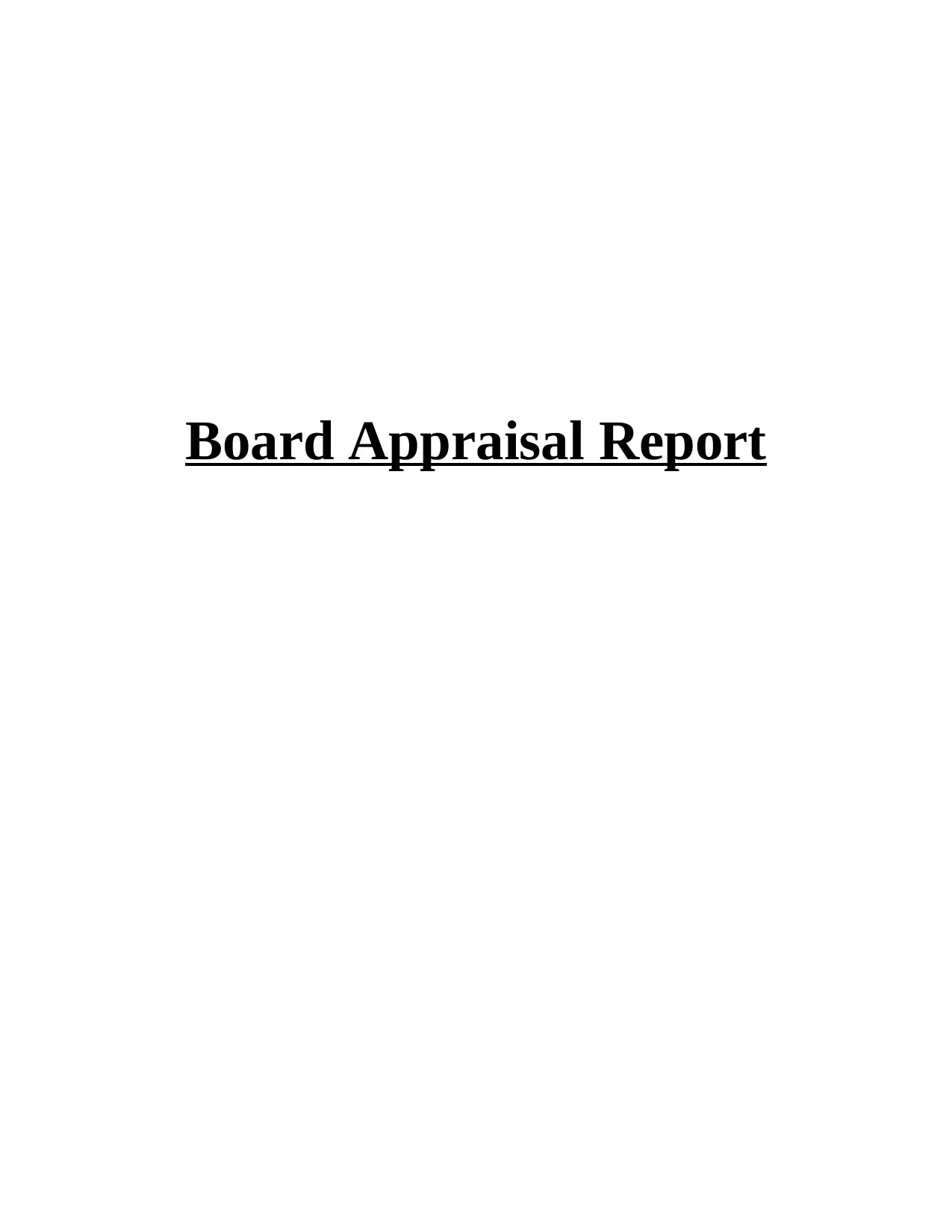
Board Appraisal Report
Paraphrase This Document
Need a fresh take? Get an instant paraphrase of this document with our AI Paraphraser
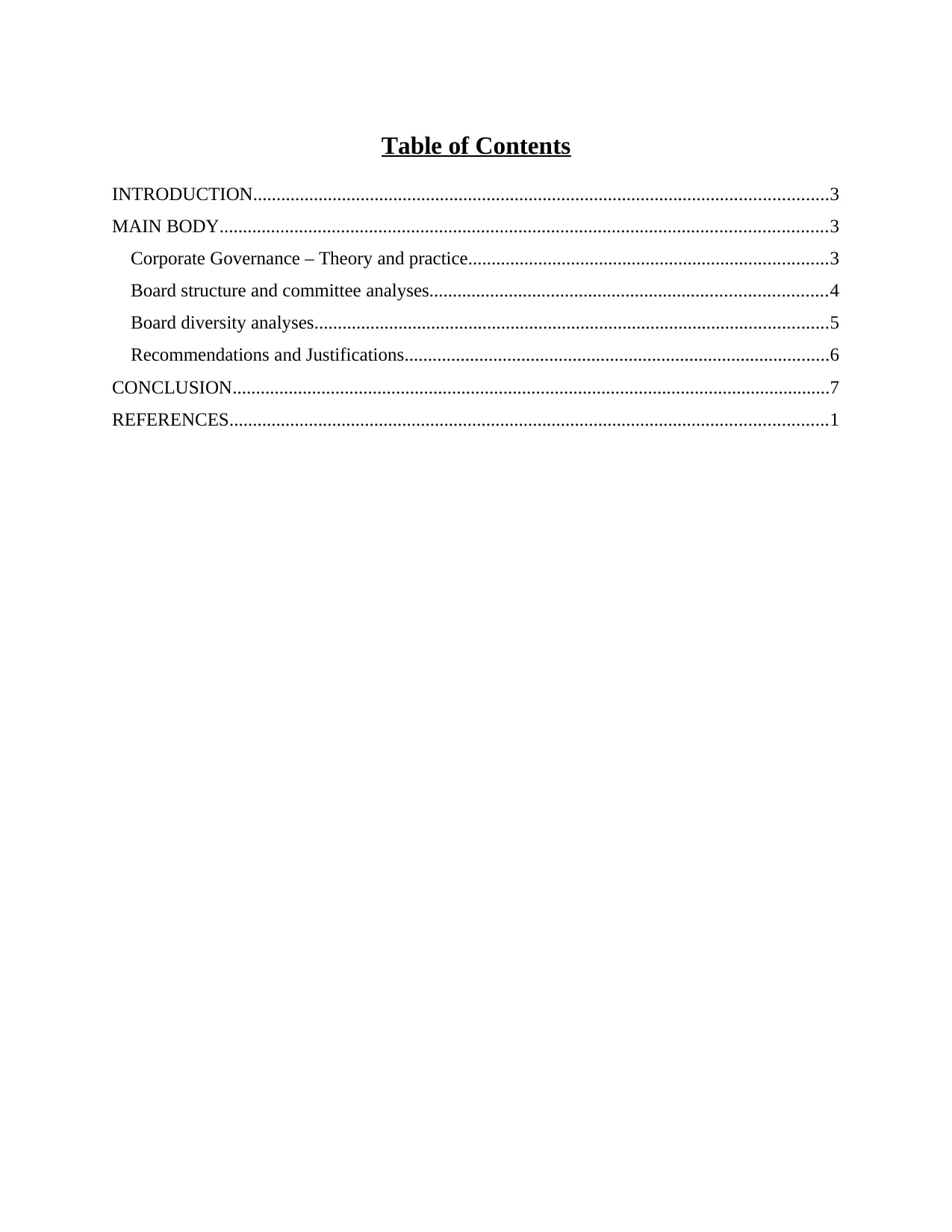
Table of Contents
INTRODUCTION...........................................................................................................................3
MAIN BODY..................................................................................................................................3
Corporate Governance – Theory and practice.............................................................................3
Board structure and committee analyses.....................................................................................4
Board diversity analyses..............................................................................................................5
Recommendations and Justifications...........................................................................................6
CONCLUSION................................................................................................................................7
REFERENCES................................................................................................................................1
INTRODUCTION...........................................................................................................................3
MAIN BODY..................................................................................................................................3
Corporate Governance – Theory and practice.............................................................................3
Board structure and committee analyses.....................................................................................4
Board diversity analyses..............................................................................................................5
Recommendations and Justifications...........................................................................................6
CONCLUSION................................................................................................................................7
REFERENCES................................................................................................................................1
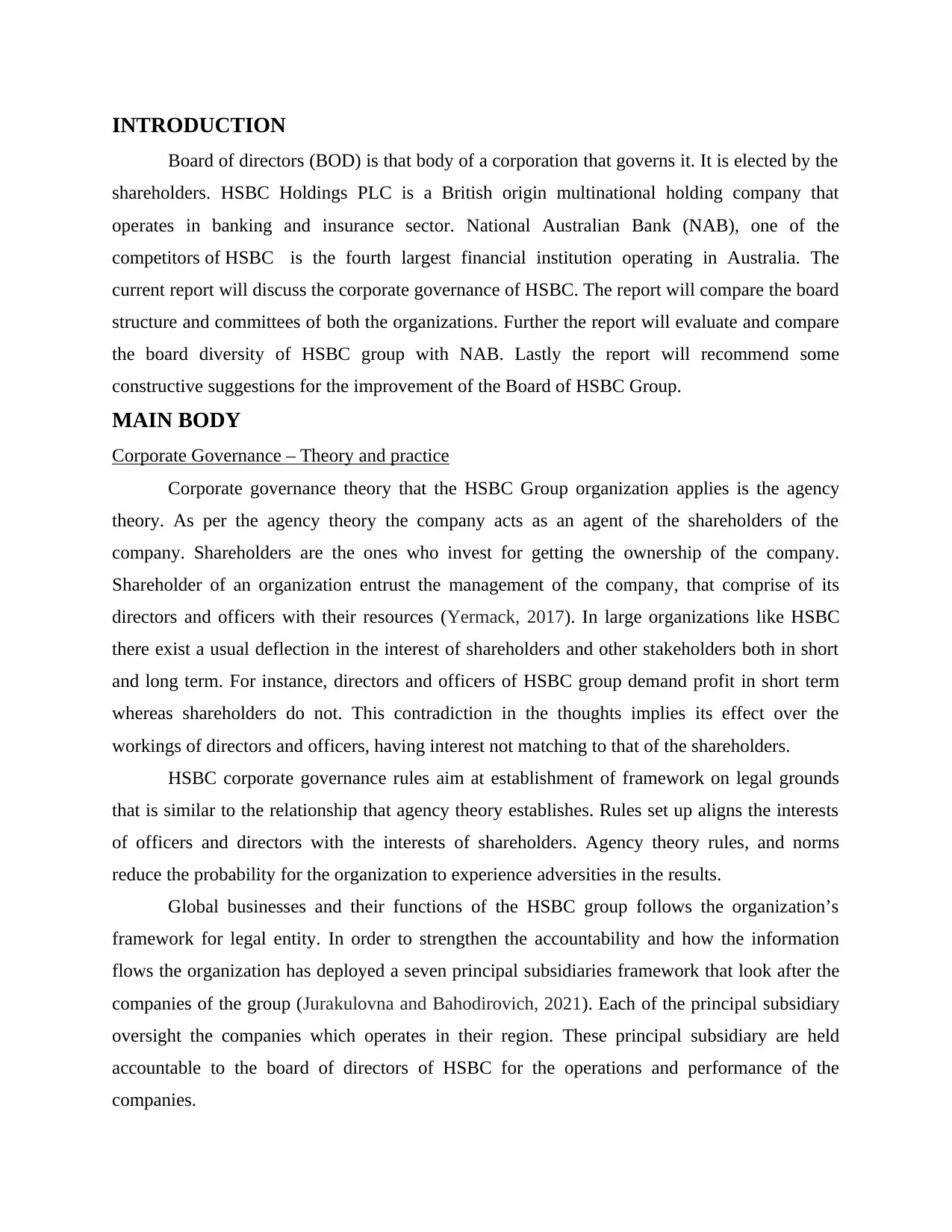
INTRODUCTION
Board of directors (BOD) is that body of a corporation that governs it. It is elected by the
shareholders. HSBC Holdings PLC is a British origin multinational holding company that
operates in banking and insurance sector. National Australian Bank (NAB), one of the
competitors of HSBC is the fourth largest financial institution operating in Australia. The
current report will discuss the corporate governance of HSBC. The report will compare the board
structure and committees of both the organizations. Further the report will evaluate and compare
the board diversity of HSBC group with NAB. Lastly the report will recommend some
constructive suggestions for the improvement of the Board of HSBC Group.
MAIN BODY
Corporate Governance – Theory and practice
Corporate governance theory that the HSBC Group organization applies is the agency
theory. As per the agency theory the company acts as an agent of the shareholders of the
company. Shareholders are the ones who invest for getting the ownership of the company.
Shareholder of an organization entrust the management of the company, that comprise of its
directors and officers with their resources (Yermack, 2017). In large organizations like HSBC
there exist a usual deflection in the interest of shareholders and other stakeholders both in short
and long term. For instance, directors and officers of HSBC group demand profit in short term
whereas shareholders do not. This contradiction in the thoughts implies its effect over the
workings of directors and officers, having interest not matching to that of the shareholders.
HSBC corporate governance rules aim at establishment of framework on legal grounds
that is similar to the relationship that agency theory establishes. Rules set up aligns the interests
of officers and directors with the interests of shareholders. Agency theory rules, and norms
reduce the probability for the organization to experience adversities in the results.
Global businesses and their functions of the HSBC group follows the organization’s
framework for legal entity. In order to strengthen the accountability and how the information
flows the organization has deployed a seven principal subsidiaries framework that look after the
companies of the group (Jurakulovna and Bahodirovich, 2021). Each of the principal subsidiary
oversight the companies which operates in their region. These principal subsidiary are held
accountable to the board of directors of HSBC for the operations and performance of the
companies.
Board of directors (BOD) is that body of a corporation that governs it. It is elected by the
shareholders. HSBC Holdings PLC is a British origin multinational holding company that
operates in banking and insurance sector. National Australian Bank (NAB), one of the
competitors of HSBC is the fourth largest financial institution operating in Australia. The
current report will discuss the corporate governance of HSBC. The report will compare the board
structure and committees of both the organizations. Further the report will evaluate and compare
the board diversity of HSBC group with NAB. Lastly the report will recommend some
constructive suggestions for the improvement of the Board of HSBC Group.
MAIN BODY
Corporate Governance – Theory and practice
Corporate governance theory that the HSBC Group organization applies is the agency
theory. As per the agency theory the company acts as an agent of the shareholders of the
company. Shareholders are the ones who invest for getting the ownership of the company.
Shareholder of an organization entrust the management of the company, that comprise of its
directors and officers with their resources (Yermack, 2017). In large organizations like HSBC
there exist a usual deflection in the interest of shareholders and other stakeholders both in short
and long term. For instance, directors and officers of HSBC group demand profit in short term
whereas shareholders do not. This contradiction in the thoughts implies its effect over the
workings of directors and officers, having interest not matching to that of the shareholders.
HSBC corporate governance rules aim at establishment of framework on legal grounds
that is similar to the relationship that agency theory establishes. Rules set up aligns the interests
of officers and directors with the interests of shareholders. Agency theory rules, and norms
reduce the probability for the organization to experience adversities in the results.
Global businesses and their functions of the HSBC group follows the organization’s
framework for legal entity. In order to strengthen the accountability and how the information
flows the organization has deployed a seven principal subsidiaries framework that look after the
companies of the group (Jurakulovna and Bahodirovich, 2021). Each of the principal subsidiary
oversight the companies which operates in their region. These principal subsidiary are held
accountable to the board of directors of HSBC for the operations and performance of the
companies.
⊘ This is a preview!⊘
Do you want full access?
Subscribe today to unlock all pages.

Trusted by 1+ million students worldwide

It is a legal entity that is listed so it must adhere to all the requirements that are relevant
and all the rules of London, New York, Hong Kong and Bermuda stock exchanges and UK
company law. The environment in which HSBC operates is a strongly regulated environment.
HSBC Holdings plc itself isn’t regulated but the range of subsidiaries that it owns both directly
and indirectly are the ones that are actually regulated and supervised. The subsidiaries owned by
HSBC operates in sectors like banking and insurance or securities and hence are regulated and
supervised by such industrial authorities. The HSBC Group have obligations for governance, risk
management, liquidity, capital, financial crime, conduct and systems. Further UK prudential
regulation authority regulates the group.
The corporate governance policy of the HSBC group provides guidelines for the
operational and strategic planning, management of risk and compliance to the legalities, financial
management, planning for success and culture, handling experiences of the customers and
external reporting.
Board structure and committee analyses
There are various types of board structure like a board with all executives as its members,
a board with majority of its members as executives, board with majority of members from
outside, a two tier supervisory board and advisory board. The board of HSBC comprise of
majority of members that are non-executive (Bakare, 2021). Mark E Tucker is the Group
Chairman; Noel Quinn is Group Chief Executive. Further the Board of the organization includes
group chief financial officer, eight independent non-executive directors, one senior independent
non –executive director and a group company secretary and chief governance officer. The board
of the organization is a type of board with majority of outside members.
On the other hand, the board of NAB has Philip Chronican as chairman and one of the
non –executive directors and Ross Mcewan CBE as organization’s group chief executive officer
and managing director. Further the board has seven non –executive directors. The board of NAB
is a type of board with majority of members as non –executive members.
The Group Audit Committee of HSBC has a chairman and three other members. All such
members are independent non –executive directors. This committee is responsible to monitor
financial statements integrity. Seeing financial reporting dedicated internal control systems and
monitor and review of effectivity of internal auditing are also the responsibilities. Further the
responsibilities include financial and accounting practices and policies review and external
and all the rules of London, New York, Hong Kong and Bermuda stock exchanges and UK
company law. The environment in which HSBC operates is a strongly regulated environment.
HSBC Holdings plc itself isn’t regulated but the range of subsidiaries that it owns both directly
and indirectly are the ones that are actually regulated and supervised. The subsidiaries owned by
HSBC operates in sectors like banking and insurance or securities and hence are regulated and
supervised by such industrial authorities. The HSBC Group have obligations for governance, risk
management, liquidity, capital, financial crime, conduct and systems. Further UK prudential
regulation authority regulates the group.
The corporate governance policy of the HSBC group provides guidelines for the
operational and strategic planning, management of risk and compliance to the legalities, financial
management, planning for success and culture, handling experiences of the customers and
external reporting.
Board structure and committee analyses
There are various types of board structure like a board with all executives as its members,
a board with majority of its members as executives, board with majority of members from
outside, a two tier supervisory board and advisory board. The board of HSBC comprise of
majority of members that are non-executive (Bakare, 2021). Mark E Tucker is the Group
Chairman; Noel Quinn is Group Chief Executive. Further the Board of the organization includes
group chief financial officer, eight independent non-executive directors, one senior independent
non –executive director and a group company secretary and chief governance officer. The board
of the organization is a type of board with majority of outside members.
On the other hand, the board of NAB has Philip Chronican as chairman and one of the
non –executive directors and Ross Mcewan CBE as organization’s group chief executive officer
and managing director. Further the board has seven non –executive directors. The board of NAB
is a type of board with majority of members as non –executive members.
The Group Audit Committee of HSBC has a chairman and three other members. All such
members are independent non –executive directors. This committee is responsible to monitor
financial statements integrity. Seeing financial reporting dedicated internal control systems and
monitor and review of effectivity of internal auditing are also the responsibilities. Further the
responsibilities include financial and accounting practices and policies review and external
Paraphrase This Document
Need a fresh take? Get an instant paraphrase of this document with our AI Paraphraser
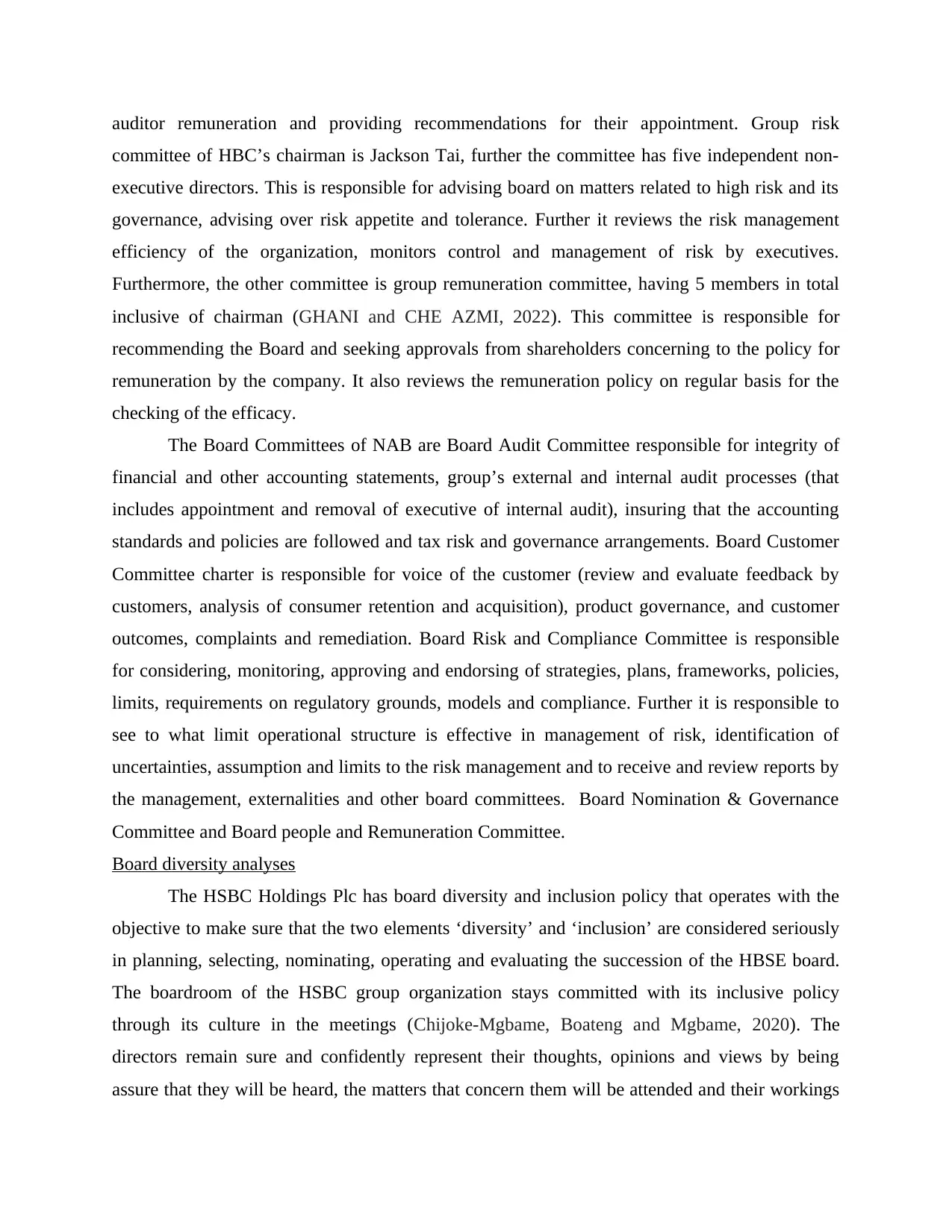
auditor remuneration and providing recommendations for their appointment. Group risk
committee of HBC’s chairman is Jackson Tai, further the committee has five independent non-
executive directors. This is responsible for advising board on matters related to high risk and its
governance, advising over risk appetite and tolerance. Further it reviews the risk management
efficiency of the organization, monitors control and management of risk by executives.
Furthermore, the other committee is group remuneration committee, having 5 members in total
inclusive of chairman (GHANI and CHE AZMI, 2022). This committee is responsible for
recommending the Board and seeking approvals from shareholders concerning to the policy for
remuneration by the company. It also reviews the remuneration policy on regular basis for the
checking of the efficacy.
The Board Committees of NAB are Board Audit Committee responsible for integrity of
financial and other accounting statements, group’s external and internal audit processes (that
includes appointment and removal of executive of internal audit), insuring that the accounting
standards and policies are followed and tax risk and governance arrangements. Board Customer
Committee charter is responsible for voice of the customer (review and evaluate feedback by
customers, analysis of consumer retention and acquisition), product governance, and customer
outcomes, complaints and remediation. Board Risk and Compliance Committee is responsible
for considering, monitoring, approving and endorsing of strategies, plans, frameworks, policies,
limits, requirements on regulatory grounds, models and compliance. Further it is responsible to
see to what limit operational structure is effective in management of risk, identification of
uncertainties, assumption and limits to the risk management and to receive and review reports by
the management, externalities and other board committees. Board Nomination & Governance
Committee and Board people and Remuneration Committee.
Board diversity analyses
The HSBC Holdings Plc has board diversity and inclusion policy that operates with the
objective to make sure that the two elements ‘diversity’ and ‘inclusion’ are considered seriously
in planning, selecting, nominating, operating and evaluating the succession of the HBSE board.
The boardroom of the HSBC group organization stays committed with its inclusive policy
through its culture in the meetings (Chijoke-Mgbame, Boateng and Mgbame, 2020). The
directors remain sure and confidently represent their thoughts, opinions and views by being
assure that they will be heard, the matters that concern them will be attended and their workings
committee of HBC’s chairman is Jackson Tai, further the committee has five independent non-
executive directors. This is responsible for advising board on matters related to high risk and its
governance, advising over risk appetite and tolerance. Further it reviews the risk management
efficiency of the organization, monitors control and management of risk by executives.
Furthermore, the other committee is group remuneration committee, having 5 members in total
inclusive of chairman (GHANI and CHE AZMI, 2022). This committee is responsible for
recommending the Board and seeking approvals from shareholders concerning to the policy for
remuneration by the company. It also reviews the remuneration policy on regular basis for the
checking of the efficacy.
The Board Committees of NAB are Board Audit Committee responsible for integrity of
financial and other accounting statements, group’s external and internal audit processes (that
includes appointment and removal of executive of internal audit), insuring that the accounting
standards and policies are followed and tax risk and governance arrangements. Board Customer
Committee charter is responsible for voice of the customer (review and evaluate feedback by
customers, analysis of consumer retention and acquisition), product governance, and customer
outcomes, complaints and remediation. Board Risk and Compliance Committee is responsible
for considering, monitoring, approving and endorsing of strategies, plans, frameworks, policies,
limits, requirements on regulatory grounds, models and compliance. Further it is responsible to
see to what limit operational structure is effective in management of risk, identification of
uncertainties, assumption and limits to the risk management and to receive and review reports by
the management, externalities and other board committees. Board Nomination & Governance
Committee and Board people and Remuneration Committee.
Board diversity analyses
The HSBC Holdings Plc has board diversity and inclusion policy that operates with the
objective to make sure that the two elements ‘diversity’ and ‘inclusion’ are considered seriously
in planning, selecting, nominating, operating and evaluating the succession of the HBSE board.
The boardroom of the HSBC group organization stays committed with its inclusive policy
through its culture in the meetings (Chijoke-Mgbame, Boateng and Mgbame, 2020). The
directors remain sure and confidently represent their thoughts, opinions and views by being
assure that they will be heard, the matters that concern them will be attended and their workings

are in an environment that is free of biases, discrimination, harassment and bullies. The Group
believes that diversity is an effective component using which it can create value difference
through its effective decision making for development of business sustainability and successful
operations. At HSBC this policy of diversity and inclusion ensures that the appointments,
nominations and succession plans of the board are on the basis of the merit and objective so that
the aspects like ethnicity, age, gender, geography, education, societal, and professionalism are
ensured.
These policies equip the board with essentialities that enable it to discharge its functions
with efficacy and effectivity. This ensures that the purpose of the group that is exploring the
world full of opportunities get fulfilled (Aljaaidi, Sharma and Bagais, 2021). The global
approach of group and various geographical regions aligns with the roots of the organization.
There are certain responsibilities of such policy of the group these responsibilities are called the
aspirational targets of the policy. HSBC is headquartered in UK to it is expected that it complies
to laws, regulations, practices prevailing in the market and diversity targets that are expected
from listed boards of UK. The board of HSBC supports the Hampton – Alexander and Parker’s
recommendation that are laid in their reviews and aspirational targets of the board. Gender
representation in the board is targeted to have at least 40 percent of female representatives by end
of year 2023 in the board of directors. Ethnic representation targets of have at least one director
of colour, defined under Parker Review.
NAB feels lucky to have talented female representatives in its board. Throughout the
NAB gender equality is there at all the levels starting from board members to the local branches.
The hiring of women at the organization is not about filling up positions with female candidates
but to hire right people into the organization that have potential to support and encourage
organizational success (Abubakar and et.al., 2018). The mentoring and networking programmes
at the company are aimed at providence of great opportunities to the women. The company is
ready with talented female employees that can take up positions in the board in future.
Recommendations and Justifications
It is recommended for the HSBC group to adopt stakeholder theory of corporate
governance. This will enable the organization to incorporate the management’s accountability
over a wide range of stakeholders. According to this theory the organizational managers
establishes a network that helps them to serve the interest of various stakeholders. The focus of
believes that diversity is an effective component using which it can create value difference
through its effective decision making for development of business sustainability and successful
operations. At HSBC this policy of diversity and inclusion ensures that the appointments,
nominations and succession plans of the board are on the basis of the merit and objective so that
the aspects like ethnicity, age, gender, geography, education, societal, and professionalism are
ensured.
These policies equip the board with essentialities that enable it to discharge its functions
with efficacy and effectivity. This ensures that the purpose of the group that is exploring the
world full of opportunities get fulfilled (Aljaaidi, Sharma and Bagais, 2021). The global
approach of group and various geographical regions aligns with the roots of the organization.
There are certain responsibilities of such policy of the group these responsibilities are called the
aspirational targets of the policy. HSBC is headquartered in UK to it is expected that it complies
to laws, regulations, practices prevailing in the market and diversity targets that are expected
from listed boards of UK. The board of HSBC supports the Hampton – Alexander and Parker’s
recommendation that are laid in their reviews and aspirational targets of the board. Gender
representation in the board is targeted to have at least 40 percent of female representatives by end
of year 2023 in the board of directors. Ethnic representation targets of have at least one director
of colour, defined under Parker Review.
NAB feels lucky to have talented female representatives in its board. Throughout the
NAB gender equality is there at all the levels starting from board members to the local branches.
The hiring of women at the organization is not about filling up positions with female candidates
but to hire right people into the organization that have potential to support and encourage
organizational success (Abubakar and et.al., 2018). The mentoring and networking programmes
at the company are aimed at providence of great opportunities to the women. The company is
ready with talented female employees that can take up positions in the board in future.
Recommendations and Justifications
It is recommended for the HSBC group to adopt stakeholder theory of corporate
governance. This will enable the organization to incorporate the management’s accountability
over a wide range of stakeholders. According to this theory the organizational managers
establishes a network that helps them to serve the interest of various stakeholders. The focus of
⊘ This is a preview!⊘
Do you want full access?
Subscribe today to unlock all pages.

Trusted by 1+ million students worldwide
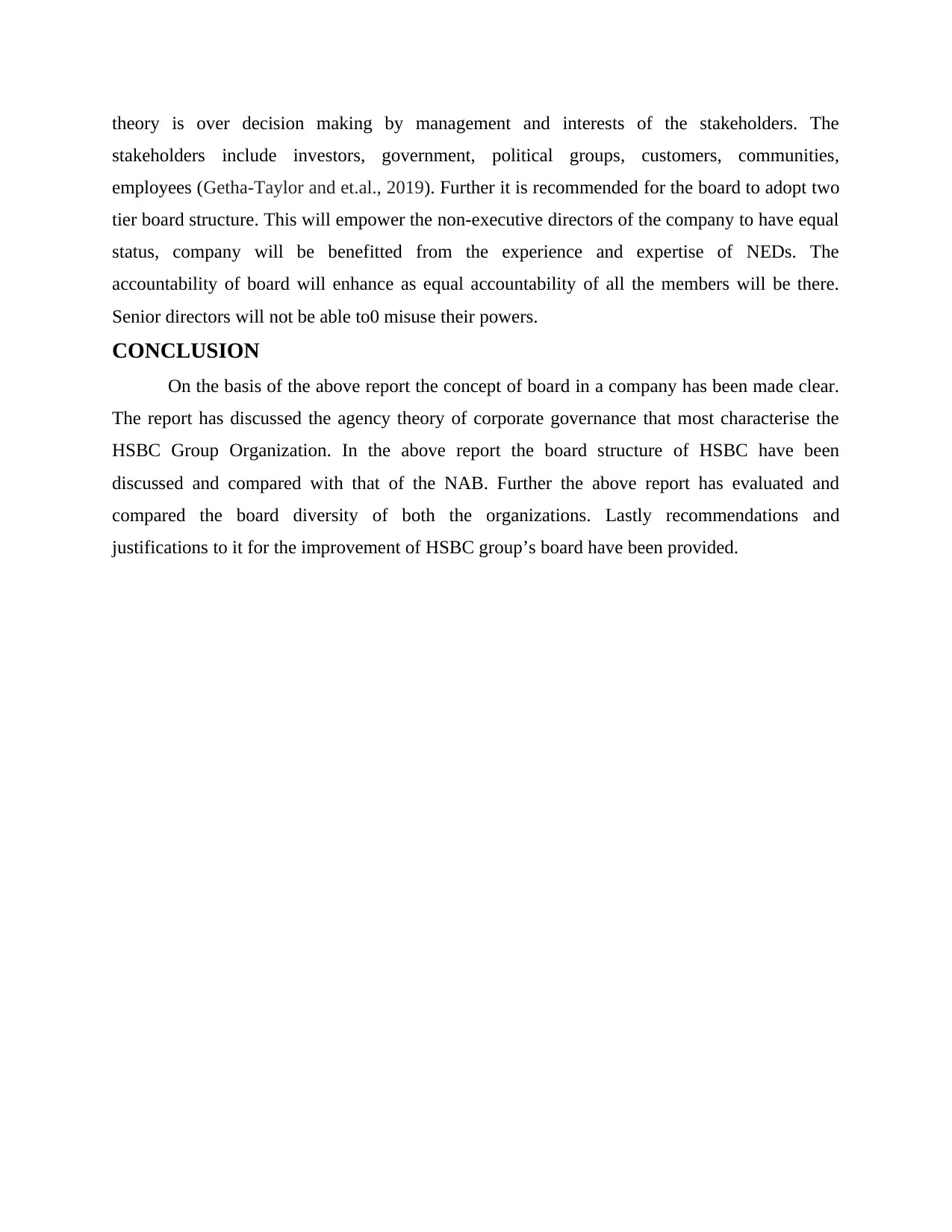
theory is over decision making by management and interests of the stakeholders. The
stakeholders include investors, government, political groups, customers, communities,
employees (Getha-Taylor and et.al., 2019). Further it is recommended for the board to adopt two
tier board structure. This will empower the non-executive directors of the company to have equal
status, company will be benefitted from the experience and expertise of NEDs. The
accountability of board will enhance as equal accountability of all the members will be there.
Senior directors will not be able to0 misuse their powers.
CONCLUSION
On the basis of the above report the concept of board in a company has been made clear.
The report has discussed the agency theory of corporate governance that most characterise the
HSBC Group Organization. In the above report the board structure of HSBC have been
discussed and compared with that of the NAB. Further the above report has evaluated and
compared the board diversity of both the organizations. Lastly recommendations and
justifications to it for the improvement of HSBC group’s board have been provided.
stakeholders include investors, government, political groups, customers, communities,
employees (Getha-Taylor and et.al., 2019). Further it is recommended for the board to adopt two
tier board structure. This will empower the non-executive directors of the company to have equal
status, company will be benefitted from the experience and expertise of NEDs. The
accountability of board will enhance as equal accountability of all the members will be there.
Senior directors will not be able to0 misuse their powers.
CONCLUSION
On the basis of the above report the concept of board in a company has been made clear.
The report has discussed the agency theory of corporate governance that most characterise the
HSBC Group Organization. In the above report the board structure of HSBC have been
discussed and compared with that of the NAB. Further the above report has evaluated and
compared the board diversity of both the organizations. Lastly recommendations and
justifications to it for the improvement of HSBC group’s board have been provided.
Paraphrase This Document
Need a fresh take? Get an instant paraphrase of this document with our AI Paraphraser
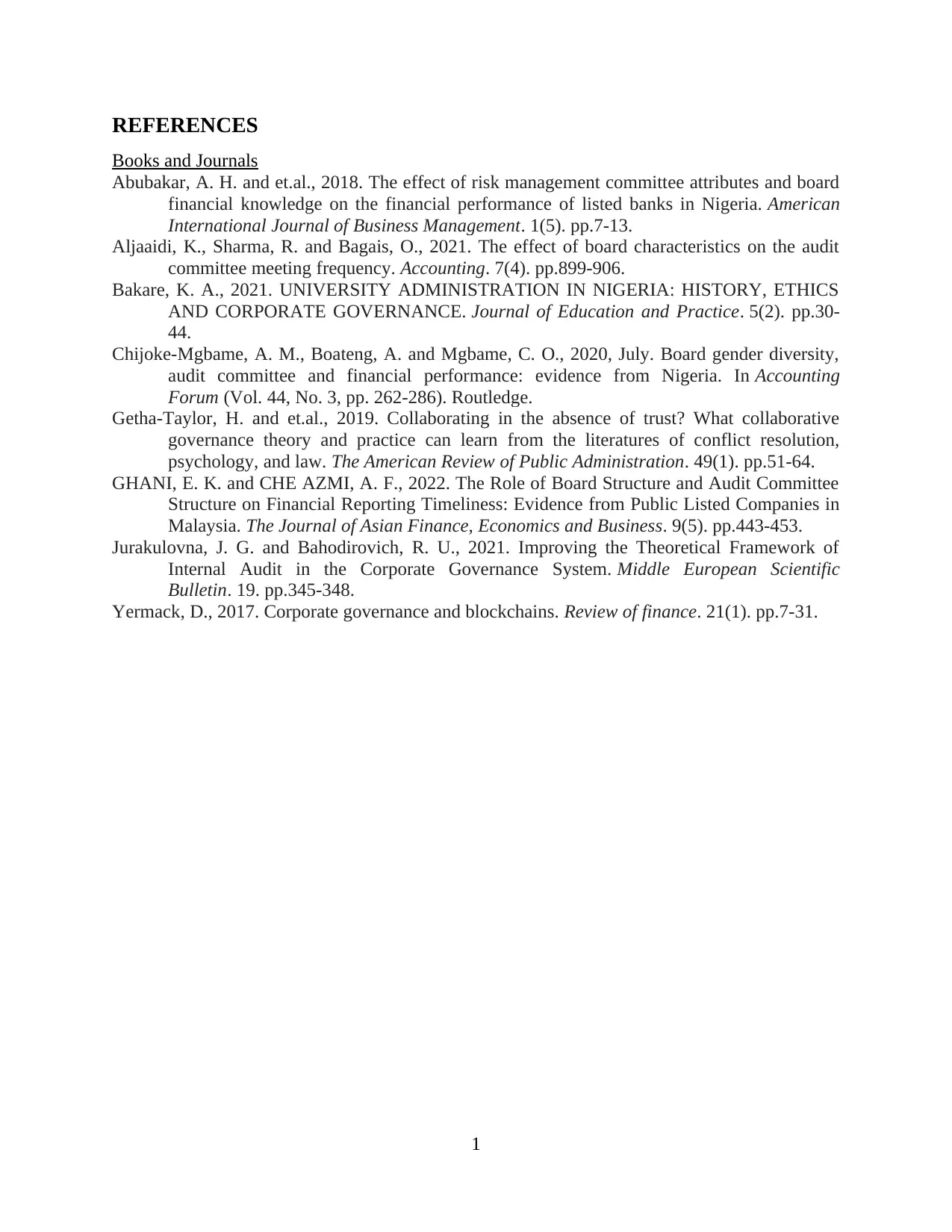
REFERENCES
Books and Journals
Abubakar, A. H. and et.al., 2018. The effect of risk management committee attributes and board
financial knowledge on the financial performance of listed banks in Nigeria. American
International Journal of Business Management. 1(5). pp.7-13.
Aljaaidi, K., Sharma, R. and Bagais, O., 2021. The effect of board characteristics on the audit
committee meeting frequency. Accounting. 7(4). pp.899-906.
Bakare, K. A., 2021. UNIVERSITY ADMINISTRATION IN NIGERIA: HISTORY, ETHICS
AND CORPORATE GOVERNANCE. Journal of Education and Practice. 5(2). pp.30-
44.
Chijoke-Mgbame, A. M., Boateng, A. and Mgbame, C. O., 2020, July. Board gender diversity,
audit committee and financial performance: evidence from Nigeria. In Accounting
Forum (Vol. 44, No. 3, pp. 262-286). Routledge.
Getha-Taylor, H. and et.al., 2019. Collaborating in the absence of trust? What collaborative
governance theory and practice can learn from the literatures of conflict resolution,
psychology, and law. The American Review of Public Administration. 49(1). pp.51-64.
GHANI, E. K. and CHE AZMI, A. F., 2022. The Role of Board Structure and Audit Committee
Structure on Financial Reporting Timeliness: Evidence from Public Listed Companies in
Malaysia. The Journal of Asian Finance, Economics and Business. 9(5). pp.443-453.
Jurakulovna, J. G. and Bahodirovich, R. U., 2021. Improving the Theoretical Framework of
Internal Audit in the Corporate Governance System. Middle European Scientific
Bulletin. 19. pp.345-348.
Yermack, D., 2017. Corporate governance and blockchains. Review of finance. 21(1). pp.7-31.
1
Books and Journals
Abubakar, A. H. and et.al., 2018. The effect of risk management committee attributes and board
financial knowledge on the financial performance of listed banks in Nigeria. American
International Journal of Business Management. 1(5). pp.7-13.
Aljaaidi, K., Sharma, R. and Bagais, O., 2021. The effect of board characteristics on the audit
committee meeting frequency. Accounting. 7(4). pp.899-906.
Bakare, K. A., 2021. UNIVERSITY ADMINISTRATION IN NIGERIA: HISTORY, ETHICS
AND CORPORATE GOVERNANCE. Journal of Education and Practice. 5(2). pp.30-
44.
Chijoke-Mgbame, A. M., Boateng, A. and Mgbame, C. O., 2020, July. Board gender diversity,
audit committee and financial performance: evidence from Nigeria. In Accounting
Forum (Vol. 44, No. 3, pp. 262-286). Routledge.
Getha-Taylor, H. and et.al., 2019. Collaborating in the absence of trust? What collaborative
governance theory and practice can learn from the literatures of conflict resolution,
psychology, and law. The American Review of Public Administration. 49(1). pp.51-64.
GHANI, E. K. and CHE AZMI, A. F., 2022. The Role of Board Structure and Audit Committee
Structure on Financial Reporting Timeliness: Evidence from Public Listed Companies in
Malaysia. The Journal of Asian Finance, Economics and Business. 9(5). pp.443-453.
Jurakulovna, J. G. and Bahodirovich, R. U., 2021. Improving the Theoretical Framework of
Internal Audit in the Corporate Governance System. Middle European Scientific
Bulletin. 19. pp.345-348.
Yermack, D., 2017. Corporate governance and blockchains. Review of finance. 21(1). pp.7-31.
1
1 out of 8
Related Documents
Your All-in-One AI-Powered Toolkit for Academic Success.
+13062052269
info@desklib.com
Available 24*7 on WhatsApp / Email
![[object Object]](/_next/static/media/star-bottom.7253800d.svg)
Unlock your academic potential
Copyright © 2020–2025 A2Z Services. All Rights Reserved. Developed and managed by ZUCOL.





